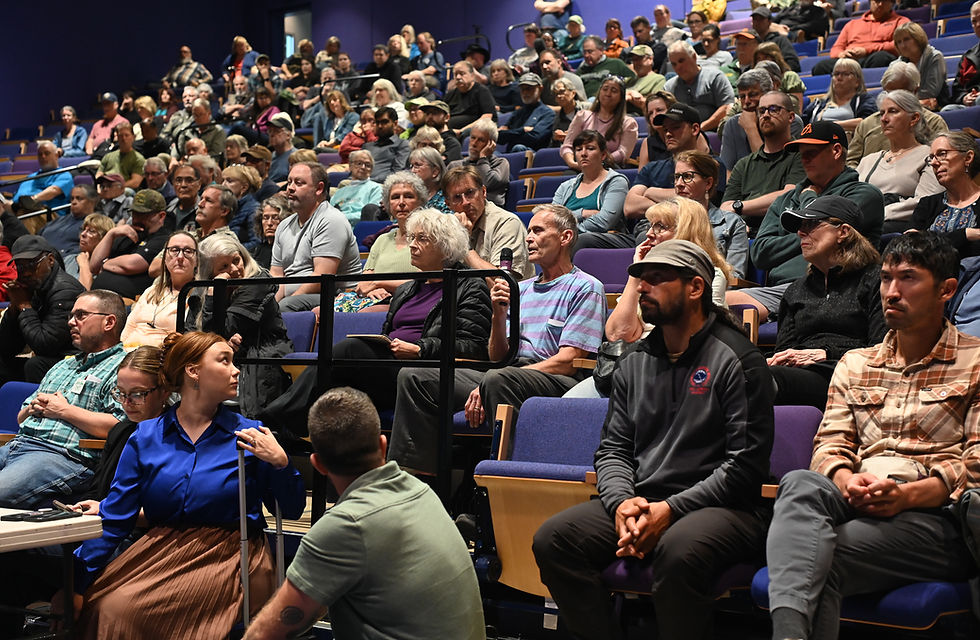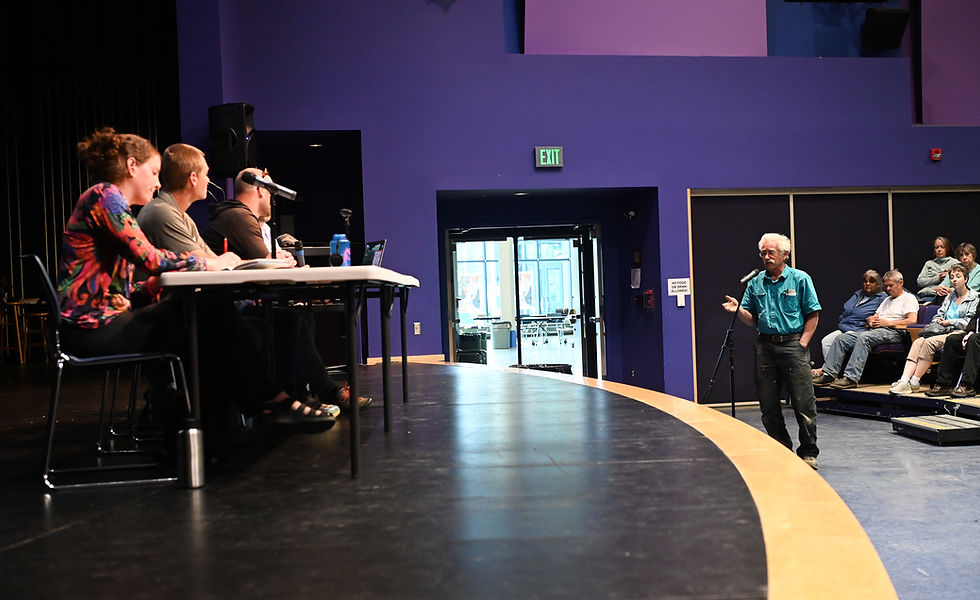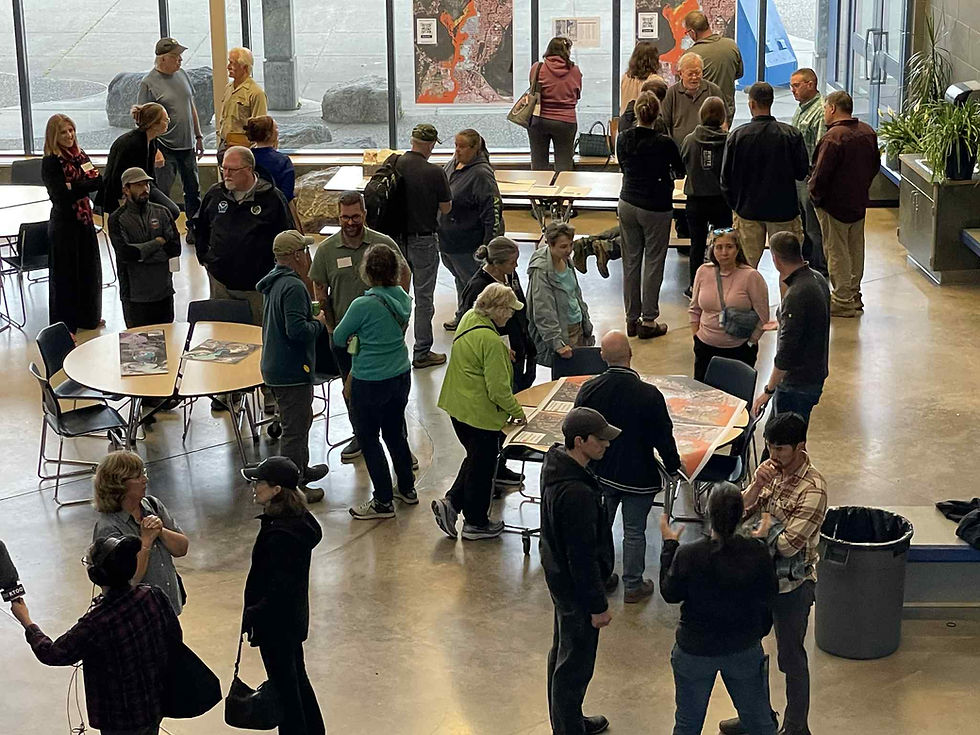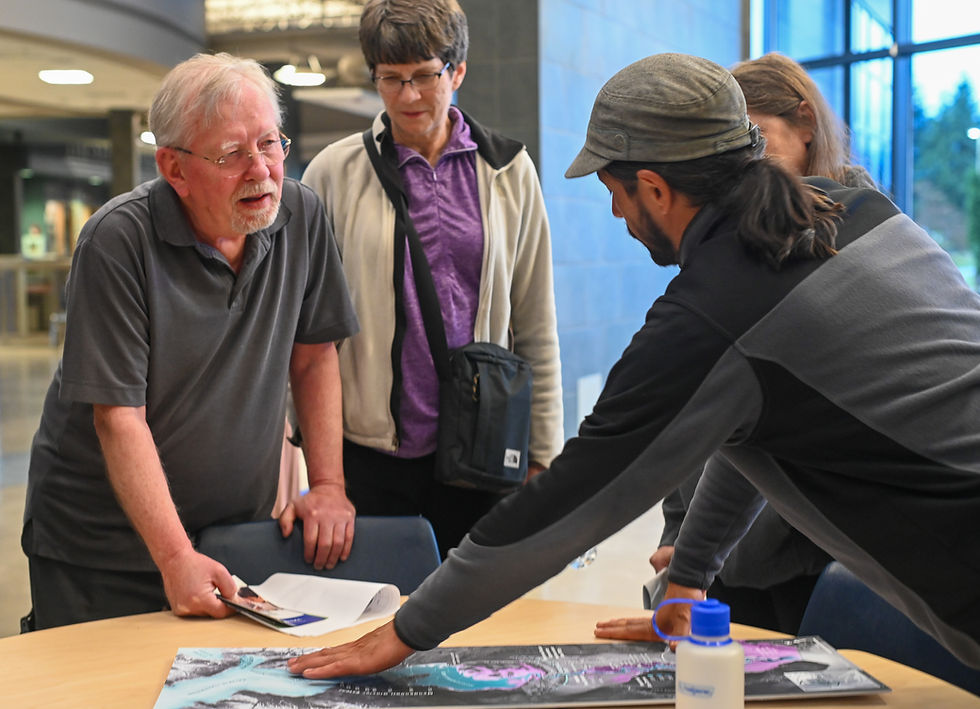A flood is expected this month. The U.S. Army Corps of Engineers says a long-term solution will take years.
- Jasz Garrett

- Aug 2
- 8 min read
Tension from earlier meetings continues as community waits for Suicide Basin to release

By Jasz Garrett and Ellie Ruel
Juneau Independent
A permanent solution for Juneau’s glacial lake outburst flooding is still expected to take up to a decade, even if some people don’t want to accept that, officials said during a U.S. Army Corps of Engineers presentation Wednesday.
Alaska’s congressional delegation and Mendenhall Valley residents have called that timeline unacceptable. A public information session provided by USACE and the City and Borough of Juneau sought to provide a general project status update at Thunder Mountain Middle School.
USACE representatives from the Civil Works Branch Alaska District gave a presentation before accepting questions. Leif Hammes, chief project manager, faced an auditorium packed with community members anxiously awaiting this year’s release from the nearly full Suicide Basin.
In March, $4.75 million was approved through the American Recovery Act for a technical study seeking a long-term solution. Hammes said the Corps is currently conducting the technical study, which will lay the groundwork for a general investigation or feasibility study.
As a government agency, the Corps is unique in that they are funded at a project level, and each project goes through a Congressional approval process.
The technical study lays the groundwork for a general investigation or feasibility study. The GI study will allow the Corps to formally recommend a solution to Congress. If the recommendation is accepted, the project can proceed to the Preconstruction Engineering and Design (PED) phase, according to USACE representatives.
“The best example I’ve ever heard of this is it’s kind of like when you go and ask your mom to or you go out to go see the movies from your parents, right? Your dad tells you, ‘Yes, you can go see the movies,’” Hammes said. “Then you have to go ask mom and say, ‘Can I have $20 to go see the movies?’ You need both those things. You need permission to go. You need the money to go.”
This particular technical investigation is being performed in lieu of some of the beginning steps of a feasibility/GI study to expedite the process.
“The idea is if we start doing data analysis, and we start deciding what is the solution we want to really push forward on that, we have a lot of all the data that we would have to collect during a GI study already at our fingertips,” Hammes said.
The Corps is collecting a wide variety of data over the next few years. Technical Lead Mike Records said this involves leveraging every resource at their disposal.
Records has installed water level gauges throughout the Valley to track this year’s outburst event.
As part of the hydraulics and hydrology data collection, the University of Alaska Southeast is conducting surveys to quantify the size and development of the basin and glacier. The U.S. Geological Survey has installed stream gauges along the outflow and into Mendenhall Lake, and is monitoring basin elevation levels. Without their equipment, monitoring the basin wouldn't be possible, according to National Weather Service Juneau and USGS.
The National Weather Service uses USGS data and LIDAR, light detecting and ranging, to model the exact water volume flowing into or out of the basin.
A second basin that is still covered by ice has been located further up. The research team said one of their questions is, “What does that look like in 50 years?” They said all of the risks must be understood to find a viable solution.
The team will use eDNA, or environmental DNA markers, to assess what species are impacted by both the flood and the potential solution for a high-level environmental impacts report. There are also economic components to the study, which will happen this fall. Hammes said the study will also have to go through the National Environmental Policy Act process.
Even though USACE’s Alaska District is having staffing issues overall, the technical study is fully funded and staffed. Planning Chief Erin Stockdale said it’s a high priority, especially given the high community impact.
“Our number-one priority is to not induce flooding where there isn’t flooding,” she said. “That’s like our baseline from where we operate. And then when we're in the study process, we define levels of risk that are acceptable, so it's risk-informed.”
The possible long-term solutions include retaining and releasing the floodwaters at either the lake or basin level, increasing the hydraulic capacity of the basin through bypass channels, or eliminating the problem at its source via a lake tap. Engineers don’t know which one will work best in this situation yet.

Dave Hanna, a lifelong Juneau resident who lives outside of the flood zone, said a dam and levee at Mendenhall Lake is the best option. He was part of a group earlier this year that submitted a proposal to the city. He said the group feels that geotechnical investigations should start immediately and the time for contemplation is past.
“If you put a dry dam across the outlet of the lake, it would serve as a pedestrian bridge,” Hanna said. “Find out what you’ve got to build on, and then figure out how to build it, because we can’t wait seven years.”
The auditorium erupted with applause.
Juneau is unique in facing this ongoing threat. There are other glacial lake outburst floods in the state, but none that affect residential areas, according to USACE.
The outbursts, which have been occurring since 2011, have reached unprecedented levels. A glacial lake outburst flood happens when a glacial dammed lake drains rapidly. In Juneau, a surge of water from Suicide Basin releases downstream into Mendenhall Lake and the Mendenhall River.
For the past two years, the Mendenhall River has crested on Aug. 6. In 2023, one home fell into the river and the eroded riverbank threatened other foundations. Last year, more than 300 homes were damaged. The river crested at a record-breaking 16 feet.
This year, HESCO barriers were installed along the Mendenhall River to offer short-term protection. Some audience members wanted to know about their feasibility and the possibility of a HESCO breach.
Such questions were dismissed since the USACE Emergency Management Program team was not present.
“Maybe next time you can bring someone from that department with you,” a person in the audience said.

Unified Command and a united community effort
City Manager Katie Koester said CBJ Engineering was available in the school commons to answer questions related to HESCO barriers. Also present were community representatives for CBJ emergency management, National Weather Service Juneau, Tlingit and Haida Public Safety, and the American Red Cross.
Currently, Suicide Basin is estimated to fill by mid-August, according to the National Weather Service Juneau’s recent forecast on Monday. But the release of Suicide Basin could happen at any time, senior services hydrologist Aaron Jacobs stressed. The basin does not have to reach capacity before it begins to drain.
“It could start releasing right now,” Jacobs said. “That’s why the monitoring program is so important.”
He said the weather service monitors activity in the basin and will update the public through a warning or an advisory.
“Once we see activity in the basin, we’ll issue a special weather statement,” he said. “We’ll be evaluating the data, and then probably soon after that, whatever the data tells us, we would issue a warning, or we’ll just update the special weather statement with the information.”

Ryan O’Shaughnessy, emergency programs manager for the city, said this is why having an action plan is so important. During his report to the Juneau Assembly on Monday, he said the community should be prepared to evacuate because it could go from the “ready” phase to the “go” phase just like that. Residents are encouraged to sign up for emergency alerts and to buy flood insurance if they have not already.
This year, the city is taking a unified command approach with the Central Council of Tlingit and Haida Indian Tribes of Alaska. The approach is to plan for the worst-possible scenario while hoping for a better one.
Tlingit and Haida is providing the facility where the Emergency Operations Center will be operated. Public Safety Manager Sabrina Grubitz said there is a meeting planned next week to discuss how volunteers will be organized. She said the Alaska Department of Transportation and Public Facilities, the U.S. Coast Guard, the Alaska Division of Homeland Security and Emergency Management, and the Alaska Department of Environment Conservation are involved in the joint flood initiative as well.
“It's tying the knot at the end of the rope here in all of our planning efforts and we're finally at that pinnacle where it's time to actually engage,” Grubitz said. “Floods are not exciting things, but it is something to say that a city and a tribe are working together so seamlessly in this. I would really say that being able to pool our resources together is something that's unusual and I think that our city and our community are going to really benefit from that.”
The American Red Cross will likely handle emergency flood sheltering and partner with the Salvation Army to supply food. The shelter will be set up at Floyd Dryden Middle School, with an initial capacity for 50 people. Red Cross volunteer Loren Jones discussed the evacuation protocols with attendees at the joint meeting.
“Roughly, we figure that 3% of the people evacuated might actually seek shelter,” Jones said. “A lot of people are already set up. They've got friends that they are going to go to, they're going to take their pets. We also expect people to drop in and ask us questions either about the shelter or about the flood.”
If more than 50 people show up at the shelter, the Red Cross can set up more cots as needed. According to Jones, they have about 12-15 volunteers who can be available to help and will staff five or six at the shelter. In the past, the organization has also done residential damage assessments, which will likely be handled by CBJ this year.
Temporary flood vehicle relocation is available for residents in the potential flood inundation area at St. Brendan's Episcopal, Christ Lutheran Church, Shepherd of the Valley and the Juneau Christian Center. Registering vehicles is required in advance.
Earlier this month, Debbie Penrose-Fischer, the leader of Juneau Flood Solution Advocates, was hoping for exactly this – direct communication from the Corps.
Her project, “Eyes on the River,” is expected to launch this week. It will install solar-powered, night-vision cameras on private property in key locations along the Mendenhall River. The project will be announced on the Juneau Flood Solution Advocates website.
The organization is also deploying volunteers on Saturday from 10 a.m. to 5 p.m. at Riverside Rotary Park to help residents place sandbags or lay down plastic. The city has also made a limited number of sandbags available to fill at Thunder Mountain Middle School.
Penrose-Fischer said she was disappointed with the project’s estimated completion from USACE. In May, Adam Telle, nominee for assistant secretary of the Army for civil works, vowed an expedited fix. On Wednesday, residents were told the reality is different. They were encouraged to reach out to the Alaska congressional delegation, who were thanked numerous times during the meeting.
Cynthia Lewis expressed hope. After the flood in 2023 washed away the foundation of condominiums along the Mendenhall River, she was displaced from her home. Lewis has since returned to living along the river and doesn’t plan to evacuate. She said she feels confident in the 2023 riverbank stabilization.
As for the HESCO barriers, she said she is not enthused and would like to understand their risks better, but she knows “you can’t just do nothing.”
Unlike Hanna, Lewis does not have a specific long-term solution in mind.
“I think they’re doing the best they can,” she said. “They are the engineers. I think their answers tonight gave me hope that they have done this all over the states. Army Corps of Engineers has had so much research in how to mitigate flood and damage. They’re the experts.”
• Contact Jasz Garrett at jasz@juneauindependent.com or (907) 723-9356. Contact Ellie Ruel at ellie.ruel@juneauindependent.com.














